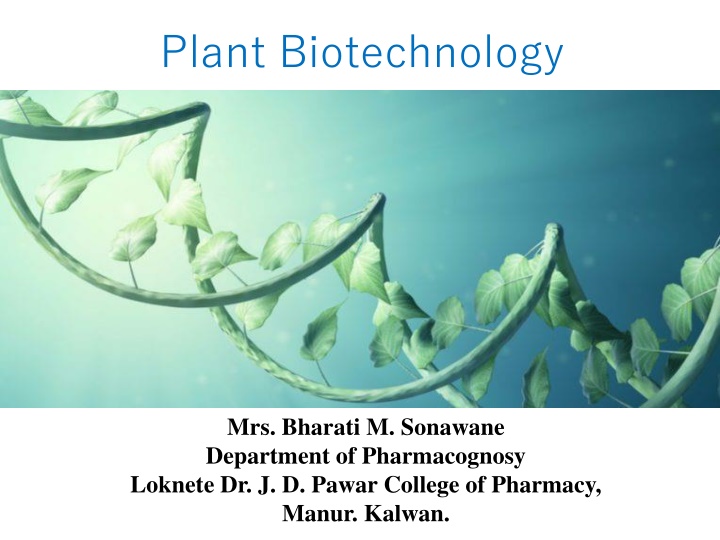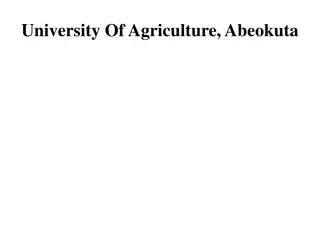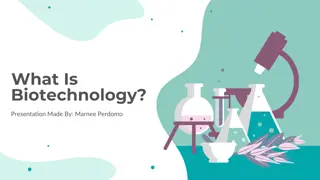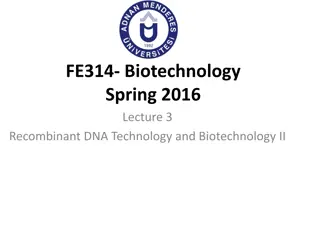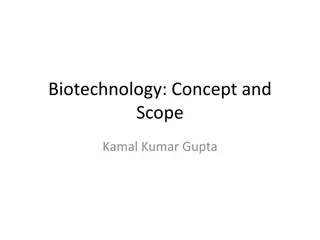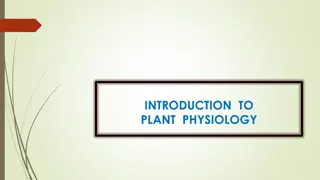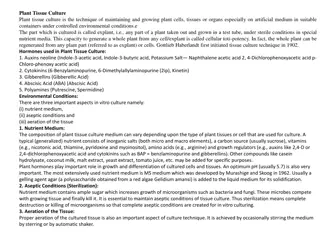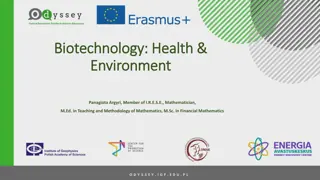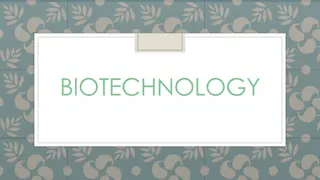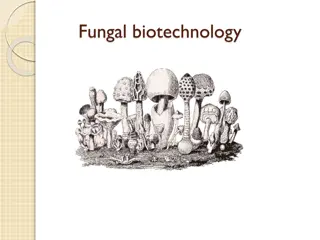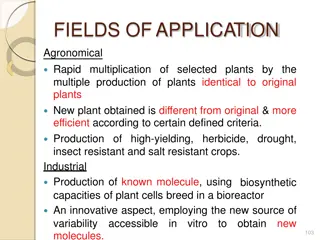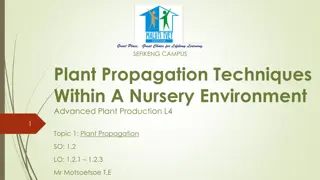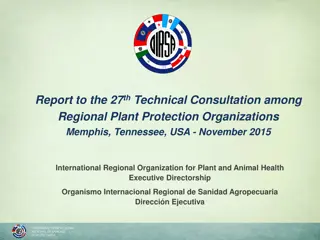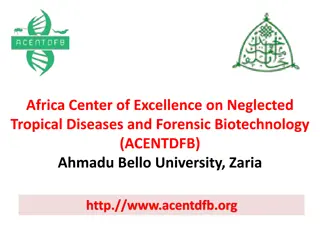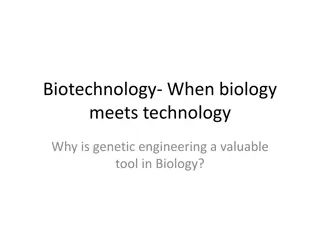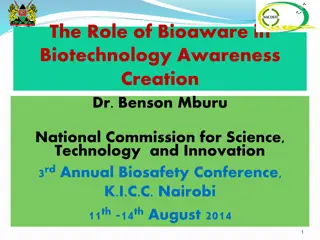Plant Biotechnology
The impact of knowing your personal strengths and weaknesses on your growth, self-confidence, and team dynamics. Discover how societal norms shape our focus on strengths versus weaknesses, and dive into various assessments like StrengthsFinder 2.0 and Richard Step Aptitude Test to gain deeper insights into your unique traits and abilities.
Download Presentation

Please find below an Image/Link to download the presentation.
The content on the website is provided AS IS for your information and personal use only. It may not be sold, licensed, or shared on other websites without obtaining consent from the author.If you encounter any issues during the download, it is possible that the publisher has removed the file from their server.
You are allowed to download the files provided on this website for personal or commercial use, subject to the condition that they are used lawfully. All files are the property of their respective owners.
The content on the website is provided AS IS for your information and personal use only. It may not be sold, licensed, or shared on other websites without obtaining consent from the author.
E N D
Presentation Transcript
Plant Biotechnology Mrs. Bharati M. Sonawane Department of Pharmacognosy Loknete Dr. J. D. Pawar College of Pharmacy, Manur. Kalwan.
Introduction: Plant biotechnology is a set of techniques used to adapt plants for specific needs or opportunities. Present definition of biotechnology Any technological application that uses biological systems, living organisms, or derivatives, theory to make or modify products or processes for specific use . The field of plant biotechnology is concerned with developing ways to improve the production of plants in order to supply the world s needs for food, fiber and fuel. In addition, plants provide us with many pharmaceuticals and industrial compounds. As our population grows, our needs also grow. To increase the quantity of crop production as well as to produce specific characteristics in plants, biotechnologists are using selective gene techniques.
Applications of Plant Tissue Culture in production of secondary metabolites: a. Production-Selection of cell lines for high yield of secondary Metabolites b. Elicitors induced production of secondary metabolites c. Biotransformation using Plant Cell Culture d. Types of cultures, Transgenic plants, Gene Trans
Why do plants produce secondary metabolites?
a. Production-Selection of cell lines for high yield of secondary Metabolites The very purpose of tissue culture is to produce high amounts of secondary metabolites. However, in general, majority of callus and suspension cultures produce less quantities of secondary metabolites. This is mainly due to the lack of fully differentiated cells in the cultures. Some special techniques have been devised to select cell lines that can produce higher amounts of desired metabolites. These methods are ultimately useful for the separation of producer cells from the non-producer cells. The techniques commonly employed for cell line selection are cell cloning, visual or chemical analysis and selection for resistance.
Cell Cloning: This is a simple procedure and involves the growth of single cells (taken from a suspension cultures) in a suitable medium. Each cell population is then screened for the secondary metabolite formation. And only those cells with high-yielding ability are selected and maintained by sub-cloning. Single cell cloning: There are certain practical difficulties in the isolation and culture of single cells.
Cell aggregate cloning: aggregate cloning is much easier, hence preferred by many workers. A schematic representation of cell aggregate cloning for the selection of cells yielding high quantities of secondary metabolites is given in Figure. A high yielding plant of the desired metabolite is selected and its explants are first cultured on a solid medium. After establishing the callus cultures, high metabolite producing calluses are identified, and they are grown in suspension cultures. Compared to single cell cloning, cell
Cell Aggregate Cloning Cell aggregates from these cultures are grown on solid medium. The developed cell aggregates (calluses) are divided into two parts. One half is grown further, while the other half is used for the quantitative analysis of metabolite produced. The cell lines with high yield of secondary metabolites are selected and used for scale- up in suspension cultures. This is followed by large scale tissue culture in a bioreactor. freshly the desired
Visual or Chemical Analysis: metabolites produced by cell lines can be done either by visual or chemical analysis. Visual identification of cell lines producing coloured secondary metabolites (pigments e.g., -carotene, shikonin) will help in the selection of high-yielding cells. This method is quite simple and non-destructive. The major limitation is that the desired metabolite should be coloured. Certain secondary metabolites emit fluorescence under UV light, and the corresponding clones can be identified. Some workers use simple, sensitive and inexpensive chemical analytical methods for quantitative estimation of desired metabolites. Analysis is carried out in some colonies derived from single cell cultures. Radioimmunoassay is the most commonly used analytical method. Micro spectrophotometry and fluorescent antibody techniques are also in use. A direct measurement of some of the secondary
Selection for Resistance: lead to the formation of mutant cells which can overproduce a primary metabolite, and then a secondary metabolite. Such mutants can be selected and used to produce the desired metabolite in large quantities. One example is described. Cell lines selected for resistance of 5-methyl- tryptophan (analogue of tryptophan) produce strains which can overproduce tryptophan. These tryptophan overproducing strains can synthesize 10-50 times higher levels of the natural auxin namely indole acetic acid (Note: The secondary metabolite indole acetic acid is derived from the primary metabolite tryptophan). Certain cells resistant to toxic compounds may
Elicitors are the compounds of biological origin which stimulate the production of secondary metabolites, and the phenomenon of such stimulation is referred to as elicitation. Elicitors produced within the plant cells are endogenous elicitors e.g., pectin, pectic acid, cellulose, other polysaccharides. When the elicitors are produced by the microorganisms, they are referred to as exogenous elicitors e.g., chitin, chitosan, glucans. All the elicitors of biological origin are biotic elicitors. The term abiotic elicitors is used to represent the physical (cold, heat, UV light, osmotic pressure) and chemical agents (ethylene, fungicides, antibiotics, salts of heavy metals) that can also increase the product formation. However, the term abiotic stress is used for abiotic elicitors, while elicitors exclusively represent biological compounds.
Phytoalexins: Plants are capable of defending themselves when attacked by microorganisms, by producing antimicrobial compounds collectively referred to as phytoalexins. Phytoalexins are the chemical weapons of defense against pathogenic microorganisms. Some of the phytoalexins that induce the production of secondary metabolites are regarded as elicitors. Some chemicals can also act as elicitors e.g., actinomycin-D, sodium salt of arachidonic acid, ribonuclease-A, chitosan, poly-L- lysine, nigeran. These compounds are regarded as chemically defined elicitors.
Interactions for Elicitor Formation: microbe interaction. Three different types of interactions between plants and microorganisms are known that lead to the formation of elicitors. Elicitors are compounds involved in plant- 1. Direct release of elicitor by the microorganisms. 2. Microbial enzymes that can act as elicitors. e.g. endopolygalacturonic acid lyase from Erwinia carotovara. 3. Release of phytoalexins by the action of plant enzymes on cell walls of microorganisms which in turn stimulate formation elicitors from plant cell walls e.g., chitosan from Fusarium cell walls; -1, 3- endoglucanase from Phytophthora cell walls.
Methodology of Elicitation: Selection of microorganisms: bacteria, algae and fungi) that need not be pathogens have been tried in cultures for elicitor induced production of secondary metabolites. Based on the favourable elicitor response, an ideal microorganism is selected. The quantity of the microbial inoculum is important for the formation elicitor. A wide range of microorganisms (viruses, Co-culture: are inoculated with the selected microorganism to form co-cultures. The cultures are transferred to a fresh medium prior to the inoculation with microorganism. This helps to stimulate the secondary metabolism. Co-cultures of plant cells with microorganisms may sometimes have inhibitory effect on the plant cells. In such a case, elicitor preparations can be obtained by culturing the selected microorganism on a tissue culture medium, followed by homogenization and autoclaving of the entire culture. Plant cultures (frequently suspension cultures)
This process releases elicitors. In case of heat labile elicitors, the culture homogenate has to be filter sterilized (instead of autoclaving). In some co-culture systems, direct contact of plant cells and microorganisms can be prevented (entrapment) of one of them. In these cultures, plant microbial interaction occurs by diffusion of the elicitor compounds through the medium. by immobilization Mechanism of Action of Elicitors: increase the synthesis of mRNAs encoding enzymes responsible for the ultimate biosynthesis secondary metabolites. There are some recent reports suggesting the involvement of elicitor mediated calcium-based signal transduction systems that promotes the product formation. When the cells are pretreated with a calcium chelate (EDTA) prior to the addition of elicitor, there occurs a decrease in the production of secondary metabolite. Elicitors are found to activate genes and
cell cultures is the large scale production of cardiovascular drug digoxin from digitoxin by Digitali lanata. Digoxin production is carried out by immobilized cells of D. lanata in airlift bioreactors. Cell cultures of Digitalis purpurea or Stevia rebaudiana can convert steviol into steviobiocide and steviocide which are 100 times sweeter than cane sugar. A good example of biotransformation by plant
Elicitor-induced products in cultures: List of Elicitor-Induced Secondary Metabolite Production
Plant Biotechnology Mrs. Bharati M. Sonawane Department of Pharmacognosy Loknete Dr. J. D. Pawar College of Pharmacy, Manur. Kalwan.
C. Biotransformation using Plant Cell Culture: The conversion of one chemical into another (i.e., a substrate into a final product) by using biological systems (i.e. cell suspensions) as biocatalysts is regarded as biotransformation or bioconversion. The biocatalyst may be free or immobilized, and the process of biotransformation may involve one or more enzymes. The biotechnological application of plant cell cultures in biotransformation reactions involves the conversion of some less important substances to valuable medicinal or commercially important products. In biotransformation, it is necessary to select such cell lines that possess the enzymes for catalysing the desired reactions.
Bioconversions may involve many types of reactions e.g., hydroxylation, reduction, glycosylation. A good example of biotransformation by plant cell cultures is the large scale production of cardiovascular drug digoxin from digitoxin by Digitali lanata. Digoxin production is carried out by immobilized cells of D. lanata in airlift bioreactors. Cell cultures of Digitalis purpurea or Stevia rebaudiana can convert steviol into steviobiocide and steviocide which are 100 times sweeter than cane sugar.
D. Types of cultures: Callus culture Organ culture Single cell culture Suspension culture Embryo culture Anther culture Pollen culture Somatic Embryogenesis Protoplast Culture Shoot tip and Meristem culture Explant Culture
Callus culture: Callus culture may be defined as production and maintenance of an unorganized mass of proliferative cell from isolated plant cell, tissue or organ by growing them on artificial nutrient medium in glass vials under controlled aseptic conditions. Organ culture: That may allow differentiation and preservation of the architecture. The organ culture refers to the in vitro culture and maintenance of an excised organ primordial or whole or part of an organ in way and function. Single cell culture: Single cell culture is a method of growing isolated single cell aseptically on nutrient medium under controlled condition.
Suspension culture: Suspension culture is a type of culture in which single cell or small aggregates of cell multiply while suspended in agitated liquid medium. Suspension cultures are used in induction of somatic embryos and shoots, production of secondary metabolites, in vitro mutagenesis, selection of mutants and genetic transformation studies. Embryo culture: Embryo culture may be defined as aseptic isolation of embryo (of different developmental stages) from the bulk of maternal tissue of mature seed or capsule and in vitro culture under aseptic and controlled physical condition in glass vials containing nutrient semisolid or liquid medium to grow directly into plantlet.
Anther culture: Androgenesis is the in vitro development of haploid plants originating from potent pollen grains through a series of cell division and differentiation. Pollen culture: Pollen culture is the in vitro technique by which the pollengrains (preferably at the microscope stages) are squeezed from the intact anther and then cultured on nutrient medium where the microspores without producing male gametes. Somatic Embryogenesis: Somatic embryogenesis is the process of a single or group of cells initiating the development pathway that leads to reproducible regeneration of non zygotic embryos capable of germinating to form complete plants
Protoplast Culture: It is the culture of isolated protoplasts which are naked plant cells surrounded by plasma membrane which is potentially capable of cell wall regeneration, cell division, growth and plant regeneration on suitable medium under aseptic condition. Meristem culture: The tips of shoots (which contain the shoot apical meristem) can be cultured in vitro producing clumps of shoots from either axillary or adventitious buds. This method can, be used for clonal propagation. Explant Culture: There are variety of forms of seed plants viz., trees, herbs, grasses, which exhibit the basic morphological units i.e. root, stem and leaves. Parenchyma is the most versatile of all types of tissues. They are capable of division and growth.
Advantages of Plant Tissue Culture: Elimination of diseases in planting material Plant improvement through tissue culture True to Type production Higher Yields Beneficial when conventional propagation is difficult Efficient method in saving space and energy Flexible method Innovation of new varieties
Plant Biotechnology Mrs. Bharati M. Sonawane Department of Pharmacognosy Loknete Dr. J. D. Pawar College of Pharmacy, Manur. Kalwan.
Plant Biotechnology Mrs. Bharati M. Sonawane Department of Pharmacognosy Loknete Dr. J. D. Pawar College of Pharmacy, Manur. Kalwan.
Transgenic plants: the controlled introduction of specific segments of DNA into a recipient plant genome, excluding an introduction by fertilization or hybridization. Agrobacterium-mediated transformation is the most widely used method for plant transformation. A. tumefaciens is a gram-negative soil bacterium which naturally Plant genetic transformation can be defined as transforms plant cells, resulting in crown gall (cancer) tumors. Tumor formation is the result of the transfer, integration and expression of genes on a specific segment of A. tumefaciens plasmid DNA called the TDNA (transferred DNA). The T-DNA resides on a large plasmid called the Ti (tumor inducing) plasmid found in A.tumefaciens.
Agrobacterium-mediated gene transfer To make a segment of DNA that contains a selectable marker and a gene of interest to look like a T-DNA. To get this T-DNA into an Agrobacterium cell so that it can be mobilized by the vir genes. To produce and find transformed plant cells that can be regenerated into normal, fertile plants.
Ti plasmid contains virulence genes necessary for transformation (vir genes), an origin of replication and the part to be transferred to host genome, which consists of sequences for auxin and cytokinin production and nopaline or octopine production. These elements in T-DNA are bordered by two border sequences (Right and Left borders). Since the border sequences define the region to be translocated into host genome, the border sequences were cloned into a plasmid vector and the auxin, cytokinin and nopaline/octopine producing elements and border sequences were deleted from Ti- plasmid.
Fig: Schematic representation of two different method to create transgenic plants.
In the Agrobacterium method (left), DNA carrying desired genes is inserted into agrobacterium and, when the bacterium infects wounded tissue, this DNA is transferred to a cell nucleus and integrated into the chromosome. In the particle gun method, metal particles coated with DNA are fired into plant cells and the DNA becomes integrated into the plant chromosome. When a new plant is regenerated from a single plant cell, all the cells in the plant carry the new genes.
Gene Transfer: Gene transfer or uptake of DNA refers to the process that moves a specific piece of DNA into cell. The directed desirable gene transfer from one organism to another and the subsequent stable integration & expression of foreign gene into the genome is referred as genetic transformation. The transferred gene is known as transgene and the organism that develop after a successful gene transfer is known as transgenic. Steps In Transformation: Identification of useful genes Designing gene for insertion Insertion of gene into target plant Identification of transgenic cells Regenerate plant compared with plant variety
Plant Biotechnology Mrs. Bharati M. Sonawane Department of Pharmacognosy Loknete Dr. J. D. Pawar College of Pharmacy, Manur. Kalwan.
GENE TRANSFER METHODS 1. Vector Mediated Gene Transfer 2. Vectorless or Direct Gene Transfer Methods VECTOR MEDIATED GENE TRANSFER Plant gene vectors being exploited for transfer of genes are plasmids of Agrobacterium, viruses & transposable elements. Vectors: Small circular DNA molecule occurring in bacteria, which can exchange between different cells under natural condition. Plasmids: Plasmids are the extra chromosomal self replicating & double stranded, closed & circular DNA molecule present in the bacterial cell.
VECTORLESS or DIRECT GENE TRANSFER: 1. Physical Gene Transfer 2. Chemical Gene Transfer 3. DNA imbibitions by cell, tissue & organ
1. Physical Gene Transfer MICROINJECTION Direct mechanical introduction of DNA under microscopical control in specific target. Microinjection is able to penetrate intact cell wall. Host range independent and does not require a protoplast regeneration system. Cells/protoplast-glass micropipette of 0.5-10.0 m diameter tips are used for transfer of macromolecule into the cytoplasm/nucleus of recipient cell/protoplast. Recipient cells can be immobilized by using methods such as agarose embedding, agar embedding, poly-lysine treated glass surface & suction holding pipette. Once injection achieved, the injected cell must be cultured properly to ensure its continued growth and development.
ELECTROPORATION Use of short electric impulse of high field strength. Electric impulses increases the permeability of protoplast and allow entry of DNA molecule into the cells, if DNA is in direct contact with the membrane. If host cell has cell walls, enzymes are used to dissolve the walls, leaving only theses protoplast and the foreign DNA is introduced via electroporation.
Electroporation pulse generated by discharging a capacitor across the electrodes in a specially designed electroporator chamber. Protoplast exposed to short electric pulse which open the transient membrane channels through which DNA can pass target cells & then cultured in vitro on appropriate media. Protoplast in ionic solution containing the vector DNA are suspended between electrodes & due to high voltage, pores are made on the walls of protoplast which facilitate the entry of DNA.
2. Chemical Gene Transfer PEG MEDIATED GENE TRANSFER First conclusive demonstration of uptake & integration of isolated Ti plasmid DNA into plant protoplast was reported in Petunia & tobacco in the presence of PEG/Poly L-ornithine. Protoplast are isolated-particular concentration of protoplast suspension taken in tube-followed by addition of plasmid DNA. To this 40% PEG 4000 (w/v) dissolved in mannitol & calcium nitrate solution added slowly because of high viscosity & mixture incubated for few minutes.
CALCIUM PHOSPHATE COPRECIPITATION DNA mixed with CaCl2 solution & isotonic phosphate buffer to form a DNA CaPO4 precipitate. Precipitate is allowed to react with actively dividing cells to several hours, washed and then incubated in fresh culture medium. Physiological shock with DMSO can increase the transformation efficiency to certain extent. Relative success depends on high DNA concentration and its apparent protection in the precipitate.
